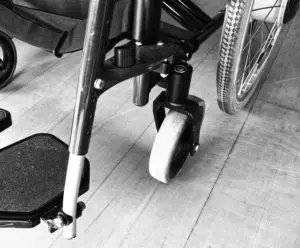Woodworking can be a difficult trade for anyone to get started in. For someone who is wheelchair-bound, it might even seem impossible. Most of the equipment that carpenters use is too high to be worked with from a sitting position, and a lot of times the wide bases don’t allow a wheelchair user to get close enough to the equipment which can cause both comfort and safety issues.
Fortunately, though, woodworking is all about modification. There are plenty of workarounds for hopeful woodworkers who don’t mind putting in the extra work. While handicapped carpenters will certainly have a more difficult time than others, it is far from impossible for them to enjoy the craft of woodworking.
Finding the Ideal Height For Tables and Saws
The first obstacle that a wheelchair-bound carpenter will encounter is height. A comfortable working height for a handicapped carpenter is going to be much lower than it is for most. The average adult in a wheelchair has an overhead reach of about 54″ to 58″, and about 44″ between their hand and the floor when holding their arm out at shoulder level. This means that any surface that is 44″ high is going to be extremely unwieldy, and anything higher is downright unsafe.
To determine the ideal height for the surfaces in your wheelchair accessible shop, measure the distance between your hand and the floor when holding your arm out straight in front of you. Subtract ~6″ from that measurement and you should be left with a comfortable and safe working height. For example, if your hand is 40″ above the ground while sitting in a wheelchair, then you should try to make as many of the surfaces in your shop 34″ high as you can. Some even recommend going as low as 30″. You can find what works for you by measuring tables and countertops already in your home, or by purchasing an adjustable workbench and seeing which height you prefer.
There are some table and miter saws that come with adjustable heights, but very few that are made to be wheelchair accessible. Even if you can adjust them to your desired height, they usually have a base that prevents you from being able to work comfortably with the machinery. This means that you will most likely have to purchase equipment that allows for some modification.
Machinery that can be mounted to a wooden workbench or countertop is your best bet. By purchasing equipment that can be mounted, you can build your worktables and surfaces to your own specifications and attach the tools to those surfaces once they’re finished.
Create A Floor Plan That Allows For Travel
Something else that a wheelchair-bound woodworker will need to keep in mind is navigation. In general, wheelchairs need at least 40″ of width for traveling in a straight line, and 60″ of space to rotate in a complete circle. This means that when designing your workshop, all of the paths should be at least 40″ wide, and places where you will need to make turns or work at a table should have around 60″ of space. The best way to organize your workspace is to set it up in rows and aisles.
 This will make it easy to navigate from one machine to the next while still leaving you enough space to work comfortably. Try to keep as many cords and hoses off of the floor as possible so that they won’t get in your way during travel. Having a few power poles along your aisles is a good way to keep your cord clutter to a minimum. There are also retractable cord reels that make it easy to grab and put away an extension cord as needed. For dust collecting ducts, keep them along the walls and corners of the room so that they don’t limit your mobility.
This will make it easy to navigate from one machine to the next while still leaving you enough space to work comfortably. Try to keep as many cords and hoses off of the floor as possible so that they won’t get in your way during travel. Having a few power poles along your aisles is a good way to keep your cord clutter to a minimum. There are also retractable cord reels that make it easy to grab and put away an extension cord as needed. For dust collecting ducts, keep them along the walls and corners of the room so that they don’t limit your mobility.
Long tables will compliment an aisle and row layout nicely, as well as giving you plenty of space to work at. You can purchase wheelchair accessible tables or even make them yourself. Long worktables also give you a lot of storage space underneath for things like shop vacuums, toolboxes, and drawers.
Material And Storage Management
Another difficulty that wheelchair users face is managing their materials. Moving boards, sheets, and stacks of lumber can be a pain even when you’re not bound to a wheelchair. To make the task easier, you can have sheets and boards cut down into more manageable sizes while you’re at your preferred lumberyard or home center store. Many of these places will do this for free, which will make things much more manageable when you’re back in your own shop.
If you would prefer to cut bulky pieces down on your own, a track saw is an invaluable tool for doing so. There are also mobile table carts that raise and lower hydraulically; having a few of these around the shop can make moving heavy amounts of wood much easier. Not to mention that they’re extremely multipurpose, and can also be used as in-feed or out-feed tables.
Wheelchair Accessible Machines And Equipment
Most woodworking equipment is not intended to be operated from the sitting position, which makes finding tools a bit of a challenge. Luckily, some manufacturers have worked to solve this problem for wheelchair users and offer creative solutions that can make your time in the shop a much smoother process.
 While not exactly a “woodshop” tool, a sturdy grabber can make it much easier to retrieve tools and other small items from shelves, countertops, and the floor. They also make special lap belts for wheelchair-bound carpenters. They fit like an apron and have plenty of pockets to keep hand tools and small hardware close by.
While not exactly a “woodshop” tool, a sturdy grabber can make it much easier to retrieve tools and other small items from shelves, countertops, and the floor. They also make special lap belts for wheelchair-bound carpenters. They fit like an apron and have plenty of pockets to keep hand tools and small hardware close by.
You can purchase a sit-down lathe, which is popular even among non-handicapped carpenters. A sit-down lathe will offer you plenty of leverage and control from a sitting position, while still giving you the same functionality as a traditional lathe. For moving heavy equipment and materials, you can purchase an electronic, remote-controlled hoist.
Using remotes or key fobs for dust collectors and other powered equipment can save you a lot of time and energy navigating through your shop. There are even some custom woodworking power outlets that will automatically enable the dust collector as soon as you turn on a connected tool.
Alternative Ideas
While working from a wheelchair is a challenge, no doubt, it does give you the chance to think outside the box and come up with your own unique workflow. While most of the previously mentioned solutions are pretty standard for most wheelchair-bound woodworkers, there are a few alternatives that could work just as well.
One such example is instead of lowering the working height of everything in your shop, create raised platforms and pathways throughout the space with wheelchair ramps. This would bring you up to the height of the tools you are working at and provide you with some extra storage underneath you. You could use this extra space for routing wires and hoses through your shop so that they are completely out of your way. Just make sure that if you do decide to try this method that you make the paths wide enough for you to comfortably rotate and maneuver. Adding railing would also help make it a safe and convenient solution.
Conclusion
Woodworking from a wheelchair is no easy task, and unfortunately, there haven’t been many carpentry equipment manufacturers addressing the issue. However, this doesn’t mean that someone can’t participate in woodworking just because they are confined to a wheelchair.
The spirit of woodworking is to rethink your environment and create your own space that functions the way you want it to. So long as you keep safety in mind while designing your woodshop, you should be able to come up with a solution that makes your shop work for you.





